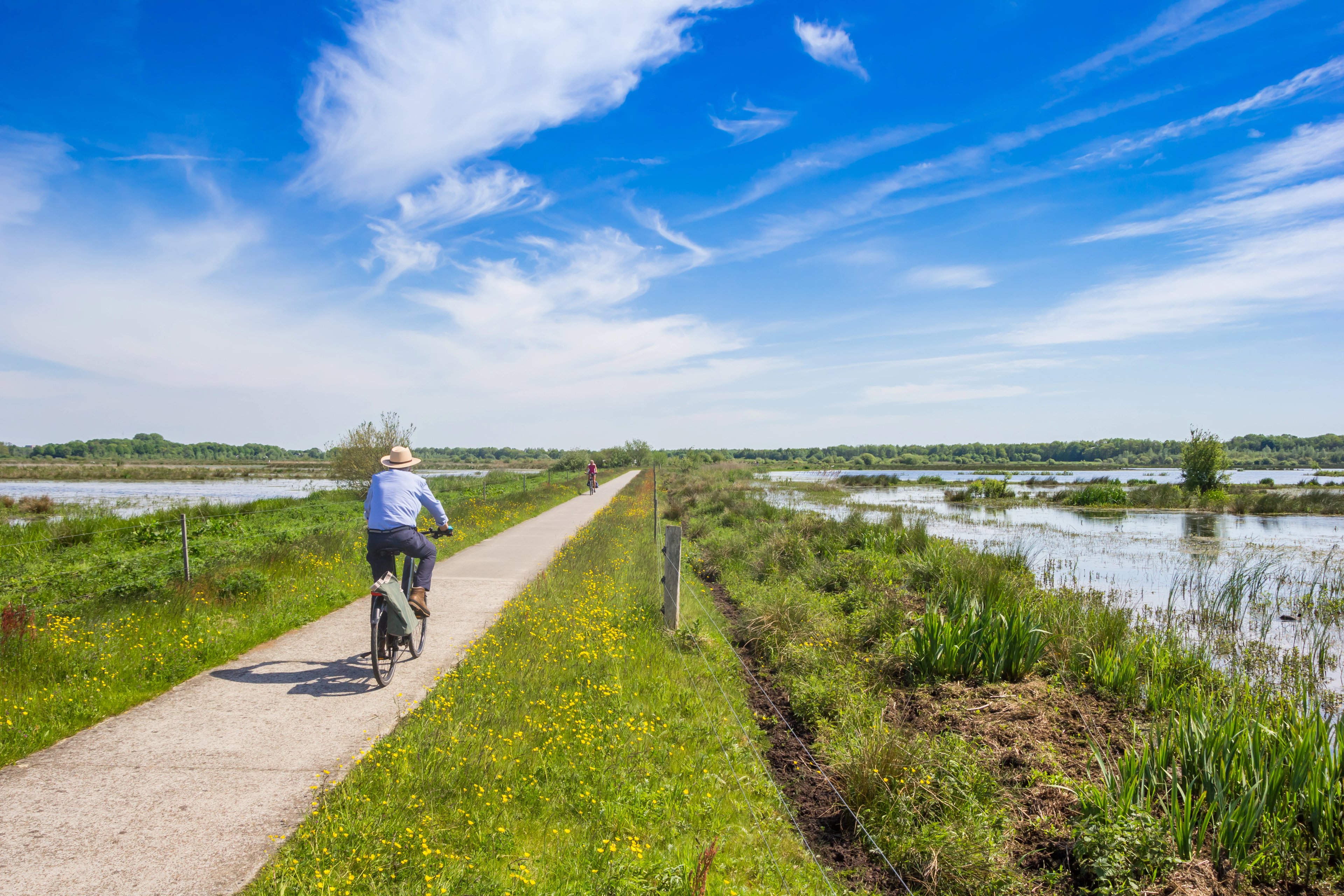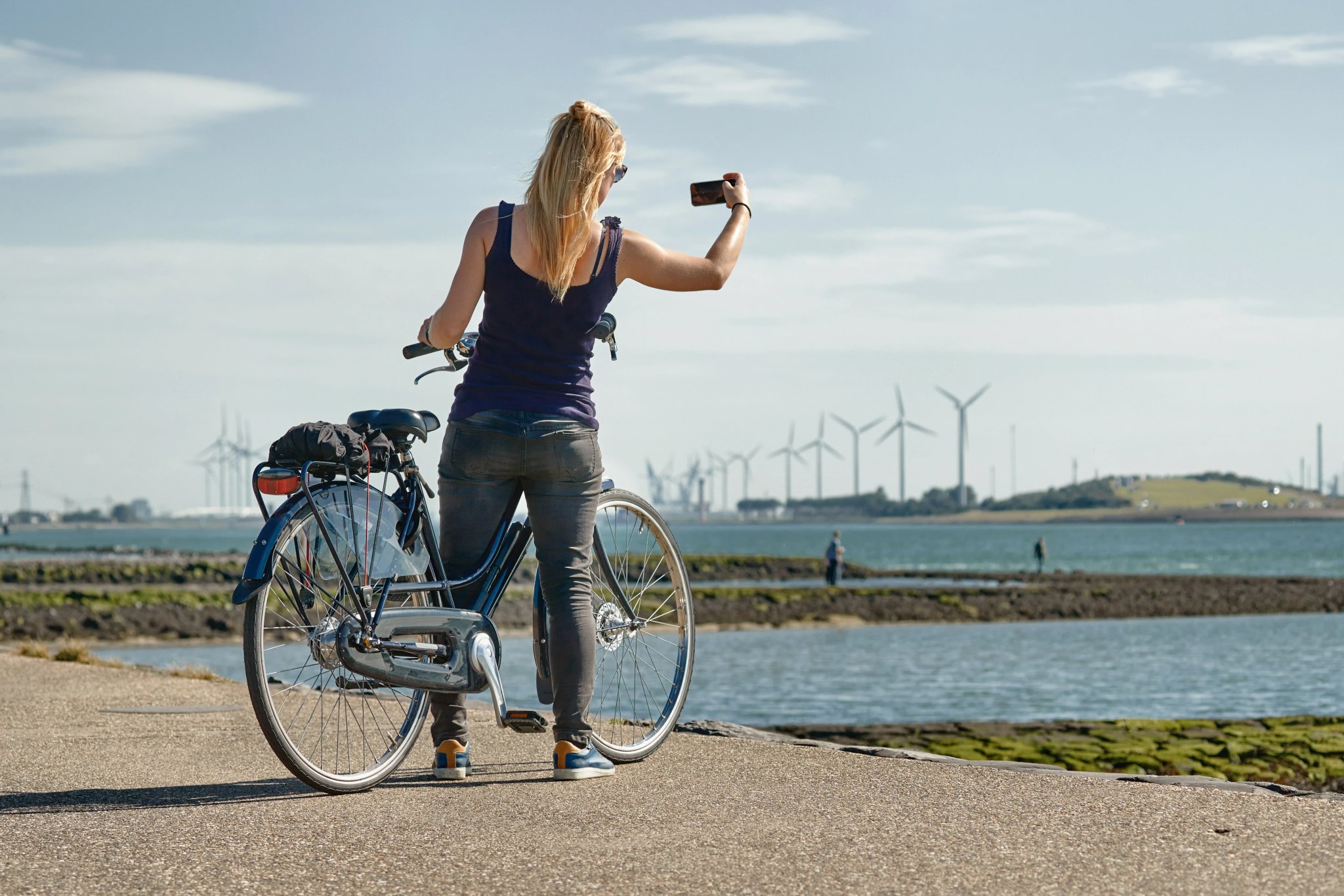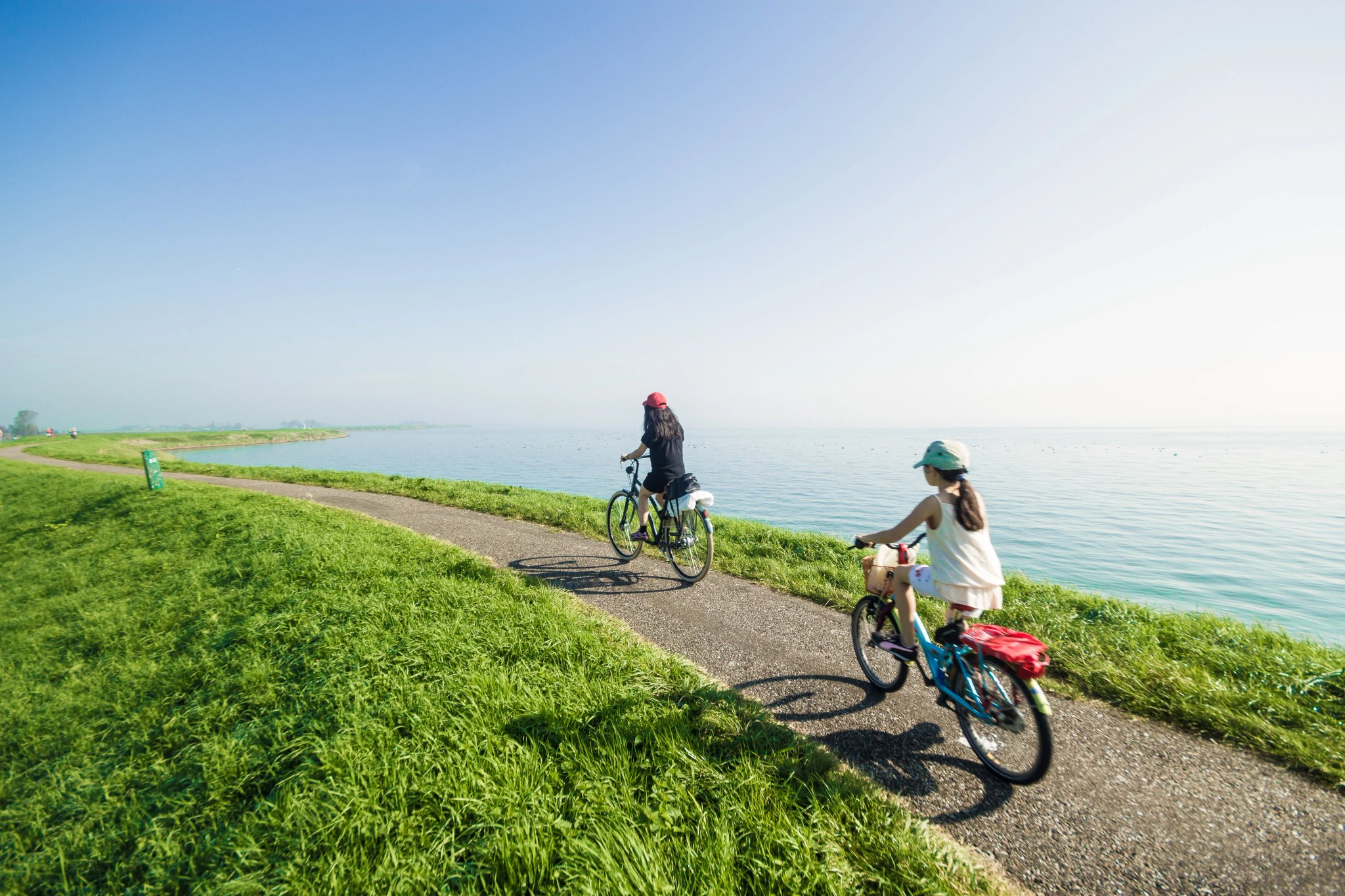Sehenswertes auf einem Radurlaub in den Niederlanden
Holland ist mehr als Tulpen und Kanäle – entdecken Sie die besten Highlights von Amsterdams Wasserwegen bis zu den Windmühlen von Kinderdijk auf einer unvergesslichen Radtour.

Die Niederlande sind ein kompaktes Land, das mit historischen Städten, zeitlosen Dörfern und Landschaften, die zum Radfahren einladen, gefüllt ist. Jeder Halt vereint Kultur, Geschichte und Landschaft und verwandelt jede Fahrt in eine Reise durch das niederländische Erbe.
Dies sind die Orte, die jeder Radfahrer auf seiner Liste haben sollte während unserer Radtouren, basierend auf den Regionen, in denen sie sich befinden.

Top-Radziele der Niederlande:
1. Südholland – Tulpen, Kanäle und kulturelle Ikonen
Südholland ist eine der ikonischsten Radregionen der Niederlande, wo das flache Terrain einfache Strecken ermöglicht und jede Etappe an einer Mischung aus Erbstädten, Windmühlen und Blumenfeldern vorbeiführt.
Von den Kanälen Delfts bis zum Tulpenfeld und der modernen Skyline Rotterdams vereint diese Region klassische niederländische Landschaften mit kulturellen Höhepunkten. Sie ist der Schwerpunkt der Highlights of South Holland Tour mit einigen Punkten als Teile der Amsterdam nach Brügge Tour, was sie zu einer der zugänglichsten Einführungen ins Radfahren in Holland macht.

Kinderdijk-Windmühlen
Ein UNESCO-Weltkulturerbe mit 19 Windmühlen, die in weiten Poldern stehen. Sie wurden im 18. Jahrhundert erbaut, um den Wasserstand zu regulieren, und gehören zu den am häufigsten fotografierten niederländischen Landschaften. Radwege führen direkt an den Kanälen vorbei und bieten einen nahen Blick auf die Mühlen und die umliegenden Wiesen. Bei Sonnenuntergang erzeugen die Spiegelungen im Wasser einen der unvergesslichsten Orte Hollands.

Keukenhof Gardens
Known as the “Garden of Europe,” Keukenhof opens from March to May, showcasing more than 7 million tulips and spring flowers. Vast fields outside the park light up in stripes of red, yellow, and purple, creating one of the world’s most spectacular cycling backdrops. Inside, themed gardens and pavilions celebrate Dutch horticulture in style. For many, timing a bike trip to coincide with Keukenhof’s short season is a once-in-a-lifetime experience.

Binnenhof
This medieval complex is the historic heart of Dutch politics and one of Europe’s oldest parliamentary centers still in use. Its Gothic Ridderzaal (Hall of Knights) and cobbled courtyards reflect centuries of decision-making that shaped the Netherlands. Cyclists can easily lock their bikes nearby and explore the site on foot. With its setting beside the Hofvijver lake, the Binnenhof combines history with postcard-perfect views.

Mauritshuis Museum
Famed for its Golden Age masterpieces, this intimate museum houses works like Vermeer’s Girl with a Pearl Earring and Rembrandt’s The Anatomy Lesson of Dr. Nicolaes Tulp. The collection is displayed inside a 17th-century mansion, adding to the charm of the visit. It’s a cultural highlight that pairs easily with a cycling stage through The Hague.

Nieuwe Kerk
This Gothic church dominates Delft’s main square and has served as the Dutch royal burial site since the 16th century. Its 108-meter tower offers sweeping views over Delft’s canals, rooftops, and even as far as Rotterdam on clear days. Inside, ornate tombs and stained-glass windows reveal centuries of national history. Whether climbed for the panorama or visited for its heritage, the church adds depth to a cycling pause in Delft.

Rotterdam
Rebuilt after heavy wartime destruction, Rotterdam showcases a striking contrast to Holland’s historic towns. Bold architecture like the Cube Houses and Erasmus Bridge makes the city a modern design hub, while the vast port remains one of the world’s busiest. Bike paths link its contemporary museums, bustling markets, and riverside promenades seamlessly.

Rijksmuseum
The Netherlands’ national museum, housing masterpieces by Rembrandt, Vermeer, and Van Gogh. Its grand galleries showcase 800 years of Dutch art and history, making it one of Amsterdam’s most important cultural stops. With secure bike parking nearby, it’s an easy detour for cyclists exploring the city.

Anne Frank House
One of Amsterdam’s most visited landmarks, the former hiding place of Anne Frank offers a poignant look into World War II history. Exhibits trace her life and legacy, while the preserved Secret Annex provides an unforgettable experience. Advance ticket booking is essential, especially during peak cycling season.
2. Zeeland – Inseln, Deiche und Meerblicke
Zeeland ist eine Provinz, die vollständig vom Wasser geprägt ist, mit Inseln und Halbinseln, die durch Brücken, Deiche und Fähren verbunden sind. Radfahren hier bedeutet offene Himmel, salzige Brisen und ein Gefühl von Freiheit, das einzigartig für diese Küstenregion ist.
Viele Fernradwege, einschließlich der Radtour von Amsterdam nach Brügge, führen durch Zeeland, wo Ingenieurbauwerke und maritime Städte aufeinandertreffen.

Delta Works
This vast storm surge barrier is considered one of the greatest feats of modern engineering. Stretching nine kilometers, it protects the low-lying land from the sea while doubling as a cycling route with panoramic ocean views. It’s both a practical necessity and a symbol of the country’s battle with the sea, often named the biggest anti-flood system in the entire world.

Veere Rathaus
Im 15. Jahrhundert erbaut, dominiert dieses Gebäude im gotischen Stil die kleine Hafenstadt Veere. Einst ein geschäftiges Handelszentrum, ist es heute ein reizvoller Halt, an dem Radfahrer sich ausruhen und die gepflasterten Straßen mit historischen Häusern erkunden können. Die kunstvolle Fassade des Rathauses und die Glockenspiele verleihen dem ansonsten ruhigen Dorf einen Hauch von Pracht. Eine Pause hier fühlt sich an, als würde man in das Goldene Zeitalter der Niederlande zurückradeln.

Middelburg Abbey
The medieval abbey complex in Zeeland’s capital features three distinctive towers, one of which—known as Lange Jan—rises 90 meters above the town. Cyclists can lock up nearby and climb for sweeping views over Middelburg’s rooftops and the surrounding flatlands. Inside, the abbey houses museums that trace the region’s history and art. It’s a reminder that Zeeland is not only about sea defenses but also about centuries of culture.

Westkapelle Lighthouse
This unique lighthouse is built directly into the tower of a former church, making it one of Zeeland’s most unusual landmarks. Its red beacon still guides ships safely along the coast. Cyclists approaching from the dikes see it rising suddenly above the low village rooftops. It’s a compact but striking symbol of how maritime history is woven into daily life here.

Middelburg
Nach den schweren Bombenangriffen im Zweiten Weltkrieg wiederaufgebaut, hat die Altstadt von Middelburg viel von ihrem früheren Charakter zurückgewonnen, mit lebhaften Marktplätzen, Kanälen und Giebelhäusern. Heute dient sie als kulturelles Zentrum von Zeeland und bietet zahlreiche Cafés und Restaurants für einen lohnenden Abschluss des Tages. Das Radfahren hier verbindet Erbe mit Widerstandsfähigkeit, da die Stadt ihre mittelalterliche Vergangenheit mit moderner Energie vereint.
3. Friesland & der IJsselmeer-Rand – Wasser, Wind und weite Horizonte
Friesland ist durch Wasser geprägt: Seen, Kanäle und die offene Weite des Wattenmeeres. Radfahren hier bedeutet, entlang langer Dämme zu fahren, Fähren zu Inseln zu nehmen und in kleinen Städten mit Jahrhunderten seefahrerischer Geschichte innezuhalten. Die IJsselmeer-Radschleife fängt das Wesen dieser Region ein und bietet ungeschützte, aber unvergessliche Fahrten unter weiten Himmeln.

Woudagemaal Station
A UNESCO World Heritage Site, this steam-driven pumping station from 1919 is still operational today. It represents a milestone in water management, designed to prevent flooding in low-lying Friesland. Visitors can tour the machinery halls and exhibitions, making it a fascinating cultural stop. For cyclists, it’s a reminder of the deep link between engineering and survival in the Netherlands.

Hindeloopen Painted Houses & Museum
The small fishing town of Hindeloopen is famous for its colorful painted woodwork, found in both furniture and building facades. A visit to the local museum explains this centuries-old craft, unique to the area. Narrow streets lined with decorated houses make for a picturesque cycling stop. It’s one of Friesland’s most charming examples of local identity and tradition.

Sneeker Waterpoort
This 17th-century water gate is one of Friesland’s most photographed landmarks. Built as part of Sneek’s defensive walls, it now stands as a symbol of the city’s history. The twin towers rising above the canal create a postcard-perfect scene. Passing through Sneek gives riders a chance to enjoy a lively town center while admiring its historic gateway.

Texel Dunes National Park
Though Texel is often thought of as part of North Holland, its dune landscapes tie closely to Friesland’s seafaring and island culture. The park offers cycling routes through protected dunes, wetlands, and birdwatching reserves. Ferries connect the island easily, making it a natural extension to rides along the IJsselmeer. Riders can expect wide horizons, sea breezes, and encounters with unique wildlife.

Leeuwarden
Friesland’s capital blends old and new, with canals, historic buildings, and a leaning tower known as the Oldehove. The city also has a lively cultural scene, hosting festivals and exhibitions that celebrate the province’s heritage. For cyclists, it’s a convenient and rewarding base before venturing into Friesland’s lake country. Leeuwarden brings together Friesland’s proud history and modern energy in one compact hub.
4. Limburg – Hügel, Weinberge und klassisches Radfahrgelände
Limburg ist anders als der Rest der Niederlande: sanfte Hügel ersetzen flache Polder, Weinberge bedecken die Hänge, und legendäre Anstiege prägen die Radfahrkultur. Dies ist die Provinz des Amstel Gold Race, wo jede Ecke mit der Geschichte des Radfahrens zu hallen scheint. Es ist eine natürliche Erweiterung für Fahrer, die nach der Erkundung der flacheren Regionen Hollands Höhenlagen suchen.

Valkenburg Castle Ruins
Perched above the town of Valkenburg, these ruins are the only hilltop castle remains in the Netherlands. Once a medieval stronghold, the fortress was destroyed in the 17th century but still dominates the town’s skyline. Walking or cycling up to the ruins gives both history and views across the Limburg hills. The site ties seamlessly into Valkenburg’s reputation as a hub for Dutch cycling and culture.

Caves of Fort Sint Peter
This vast network of limestone tunnels runs beneath the St. Pietersberg Fort outside Maastricht. Originally quarries, the caves later became wartime shelters and even a hiding place for art, including Rembrandt’s Night Watch. Guided tours reveal their layered history and eerie underground passages. For cyclists, it’s a fascinating diversion from the roads above, connecting history with the landscape.

Basilica of Our Lady
Dating back to the 11th century, this Romanesque church is one of the oldest and most revered in the Netherlands. Its heavy stone walls and candlelit interiors create a sense of timelessness. The treasury holds religious relics and treasures tied to Maastricht’s role as a pilgrimage site. Located right in the old town, it’s a rewarding cultural stop between rides.

Cauberg Hill
The most famous climb in Dutch cycling, the Cauberg has been central to the Amstel Gold Race for decades. Though short at just over a kilometer, its gradients of 8–12% test even seasoned riders. Amateurs can tackle it themselves, riding in the wheel tracks of legends. The summit area buzzes with cycling cafés and a proud sense of local racing tradition.

Hoensbroek Castle
One of the largest and best-preserved castles in the country, Hoensbroek spans centuries of Dutch history. Its moated towers, furnished halls, and interactive exhibits make it one of the most family-friendly castles to visit. Cycling up to the entrance feels like entering a storybook world. The castle’s scale and atmosphere set it apart from the many smaller manor houses scattered through Limburg.

Maastricht
Die südlichste der niederländischen Städte, Maastricht, vereint römische Geschichte, mittelalterliche Straßen und eine lebhafte Café-Kultur. Ihre Kopfsteinpflastergassen, Uferpromenaden und internationale Atmosphäre machen sie zu einem Highlight für Kultur und Küche. Die Stadt ist auch ein Zentrum für Radfahrer, veranstaltet Events und bietet einfachen Zugang zu den umliegenden Hügeln. Maastricht verbindet das Beste von Limburg: Geschichte, Erbe und Hügel.
Fahren Sie durch Hollands Erbe
Von den windmühlenbestückten Poldern Südhollands bis zu den gepflasterten Anstiegen Limburgs bietet das Radfahren in den Niederlanden eine Mischung aus Landschaft, Geschichte und Alltagskultur. Jede Region fügt ihren eigenen Geschmack hinzu – UNESCO-Landschaften, Ingenieurwunder, mittelalterliche Städte und lebendige Metropolen – die durch das unvergleichliche Radwegenetz des Landes miteinander verbunden sind.

Durchsuchen Sie unsere Holland-Radtouren für kuratierte Reiserouten oder kontaktieren Sie uns und lassen Sie uns Ihnen helfen, die Route zu finden, die am besten zu Ihrem Fahrstil passt.
Wir können auch jede Tour nach Ihren Wünschen anpassen und Highlights wie Maastricht, Valkenburg oder andere Orte aus unserer Liste einfügen, wenn Sie diese in Ihre Reise aufnehmen möchten.
.jpg&w=3840&q=75)

Problemlos
Wir kümmern uns um Reiserouten, Unterkünfte und alles andere, um das Sie sich lieber nicht kümmern möchten, damit Sie einen sorglosen Urlaub genießen können.

Vollständig anpassbar
Flexibilität ist unser zweiter Vorname - egal, ob Sie mehr oder weniger wollen, oder einfach nur mehr als gewöhnlich, wir machen es möglich.

Buchen Sie mit Vertrauen
Wir sind ein finanziell abgesichertes Unternehmen, das vollständig haftet und versichert ist, so dass Ihr Geld sicher ist und Sie mit Vertrauen reisen können.

Unschlagbarer Support
Unser 24/7-Kundenservice ist der Ort, an dem wir unsere Leidenschaft zeigen, indem wir Ihr Wohlbefinden zu unserer obersten Priorität machen.
